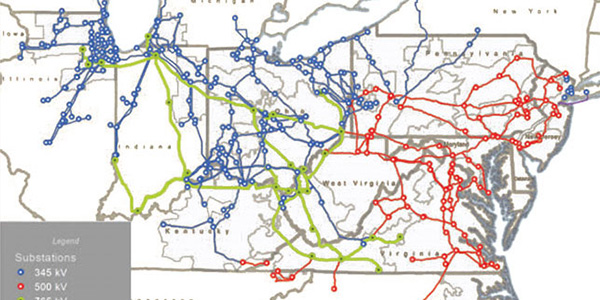PJM proposed allowing generators deemed to be critical for determining interconnection reliability operating limits to recover their required upgrade costs.
PJM has proposed developing a cost recovery mechanism for generators forced to upgrade their facilities to comply with certain NERC Critical Infrastructure Protection (CIP) standards regarding interconnection reliability operating limits (IROLs).
Darrell Frogg, senior engineer for generation at PJM, provided a first read of the problem statement and issue charge of the proposal at last week’s Operating Committee meeting.
An IROL is any system operating limit that, if exceeded, could jeopardize the entire grid. PJM is required to develop a list of “IROL-critical” facilities, Frogg said, which means the limits mostly derive from those facilities. Generators on the list may then be required to upgrade. Generation owners have no control over the IROL-critical designation, with PJM in its role as the reliability coordinator solely responsible for the list.
Frogg said PJM was making the proposal on behalf of generator owners because the classification of a generator as IROL-critical is considered critical energy/electric infrastructure information.
If approved, stakeholders would study the relevant CIP standards, review how a generator’s status is determined by PJM and consider the types of costs that generators incur from being designated. Stakeholders would also look at how other RTOs and ISOs have addressed the issue, such as FERC OKs Payment Rules for IROL Facilities.) Stakeholders would also discuss which costs should be recovered and how, and ensure the entire process is transparent.
The OC will be asked to approve the issue charge at its next meeting. Frogg said PJM hopes stakeholders will be able to make a recommendation to the Markets and Reliability Committee in three to six months. He said work updates would also be provided to the Market Implementation Committee.
David Mabry of the PJM Industrial Customer Coalition said there are “potentially significant” incremental compliance costs in the issue charge. He wondered if the OC is the proper venue to discuss the issue given the possible links to multiple committees in the issue charge.
“I’m wondering whether we ought to bring the problem statement to the MRC for approval and let the MRC decide where this is best addressed,” Mabry said.
Frogg said PJM had internal discussions to determine the best committee to deal with the issue and found that the manuals allow the OC to work out proper market incentives. PJM, however, will continue internal discussions before the next OC meeting, he said.
Resource Tracker Ownership Endorsed
Stakeholders unanimously endorsed a “quick fix” to address information entered into the Resource Tracker application used by PJM.
Chris Franks of PJM reviewed the problem statement and issue charge to update language in Manual 14D regarding the application’s ownership confirmation requirement. Franks first brought the issue to the OC last month. (See “Resource Tracker Quick Fix,” PJM Operating Committee Briefs: Feb. 11, 2021.)
The proposal includes changing “market participants are requested” to the “generation owner, or designated agent, is required” to confirm resource ownership by Nov. 1. Last year PJM requested owners of 1,503 resources to confirm their information. Of those resources, 60 did not confirm by Nov. 1. As of Feb. 1, four have yet to confirm information.
The issue charge will now go to the MRC for a final vote in April.
TLR Buy-through Quick Fix
Stakeholders also unanimously endorsed a quick fix regarding the transmission loading relief (TLR) buy-through congestion process.
Chris Advena, senior lead engineer for PJM, reviewed a problem statement and issue charge to remove the process from Schedule 1, section 1.10.6A of the OA. Advena first brought the issue to the OC in February. (See “TLR Buy-through 1st Read,” PJM MRC/MC Briefs: Feb. 24, 2021.)
TLR buy-through is the tool PJM uses to curtail interchange transactions that cause loop flow to the RTO around the time emergency procedures are being conducted to reduce the impact on a flowgate or a transmission facility. The process was created when PJM was fully within the Mid-Atlantic region and was issued more frequently than it is today, according to the RTO.
PJM is seeking final approval at the Members Committee meeting April 21.
Manual Changes Endorsed
Stakeholders unanimously endorsed two different manual changes resulting from the periodic review by acclamation.
Matthew Wharton, PJM reliability engineer, reviewed changes to Manual 37: Reliability Coordination. The changes included correction of grammatical errors, updated links and added language for an alternative method for simulating transfers.
Jeff McLaughlin, PJM senior lead engineer, reviewed changes to Manual 02: Transmission Service Request. The minor changes included fixing broken hyperlinks, updating reference document names and the consolidation and relocation of two sub-sections to a “more appropriate section” of the manual.
Both manual sections will now go for final endorsement at the March 29 MRC meeting.




